Shore Theater
The Shore Theater (formerly known as the Coney Island Theater and alternately spelled Shore Theatre), is a former theater in Coney Island, Brooklyn, New York City. The seven-story neo-Renaissance Revival building, with office space as well as a theater, is located at the intersection of Surf and Stillwell Avenues, across from Nathan's Famous and the Coney Island–Stillwell Avenue station. Completed in 1925, it was one of several structures that was intended to boost the development of Coney Island as a year-round entertainment destination. After being abandoned in the 1970s, it stood unused for several years before being developed into a hotel in the late 2010s.
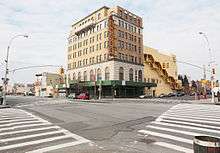 | |
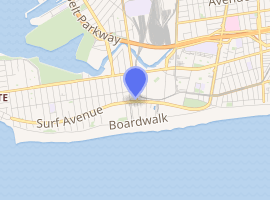
| |
| Former names | Coney Island Theater |
|---|---|
| Address | 1301 Surf Avenue |
| Location | Brooklyn, New York 11224 |
| Coordinates | 40.5758°N 73.9816°W |
| Owner | Pye Properties |
| Type | Theater |
| Construction | |
| Opened | June 17, 1925 |
| Closed | 1978 |
| Construction cost | $2 million |
| Architect | Paul C. Reilly and Douglas Pairman Hall |
History
Context and construction
The first bridge to Coney Island was established in 1824,[1][2] and this was followed five years later by the creation of the Coney Island House, a seaside resort.[2][3] Coney Island soon developed as a resort destination in the mid-19th century,[4]:15 development of which was helped by the construction of railroads after the American Civil War.[5]:182[6]:71[7] A series of fires in the resorts in the 1880s and 1890s opened up large tracts of land for the development of theme parks, of which several had been built by the first decade of the 20th century.[8]:147–150[9]:11[10]:50 Further redevelopment of Coney Island came with the opening of the New York City Subway to Stillwell Avenue in 1920 and the completion of the Riegelmann Boardwalk three years later. With this came the construction of structures such as Child's Restaurant on the Boardwalk, the Half Moon Hotel, Stauch's Baths, and various amusement rides and theaters, all during the Jazz Age in the 1920s.[11]:2
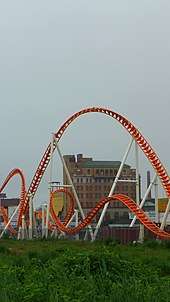
The Coney Island Theater was built on the site of the Culver Depot, a former railroad terminal that was decommissioned after the new subway terminal had opened.[11]:3 One resident on the site refused to be evicted, resulting in a court case where he was eventually paid $5,000 to move away.[12] The theater was constructed by the Chanin Construction Company, whose president Irwin Chanin said that he believed the theater would satiate "the great need in Coney Island for an all-year amusement".[13] Theater designers Paul C. Reilly and Douglas Pairman Hall were hired to design the structure, construction for which began in May 1924. The Coney Island Theater distinguished itself from other area theaters in that it was constructed with brick, limestone, and terracotta as opposed to the wooden materials used in other Coney Island structures. In addition, it provided seven stories where other Coney Island buildings were only one or two stories.[14][15] The theater also included offices intended for entertainment companies as well as shops on the Stillwell and Surf Avenue frontages. Construction was expected to cost $2 million in total.[16][17] In April 1925, the Coney Island Theater was leased to Loew's Theatres.[18]
Operation
On June 17, 1925, Loew's president Marcus Loew presided over the opening of the Coney Island Theater.[13] The attendees on its opening day included Johnny Hines, Barbara La Marr, Mae Busch, Ben Lyon, Texas Guinan, Dorothy Mackaill, Virginia Lee Corbin, and John Lowe.[11]:4 Vaudeville was added as a weekly feature in 1941.[19] For much of the next three decades, the Coney Island Theater presented vaudeville entertainment.[11]:4
By 1964, the Coney Island Theater was transferred out of Loew's control, becoming the Brandt Shore Theater.[11]:4 The theater showed only movies for the next year. However, starting January 1966, it was also used for musicals, plays, and revues.[20] Burlesque performances staged by Leroy Griffith were added in April 1966,[21] and films alongside the live entertainment would start soon afterward.[11]:6 By the early 1970s, the live shows had ended and the theater displayed adult films.[11]:6[22]
Closure and redevelopment
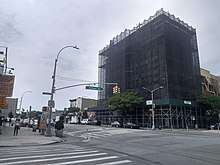
The building was sold in 1978 or 1979 to Kansas Fried Chicken owner Horace Bullard, who had bought numerous properties in Coney Island. Bullard unsuccessfully tried to renovate the theater into a hotel and casino.[22][23] Despite the redevelopment of Coney Island in the early 2000s, the Shore Theater was not developed and continued to rot.[24] Squatters and graffiti writers started to frequent the structure,[25] and while the electricity still worked, the floor was littered with rubble, according to pictures taken in 2006 by area historian Charles Denson.[26] Few people were allowed inside the building, which was heavily guarded; security was increased after a blogger was able to break in and take several images of the building.[27] The theater was made an official city landmark by the New York City Landmarks Preservation Commission in 2010.[28]
In January 2016, developer Pye Properties purchased the Shore Theater for $14 million.[22][29] No official decision was made at first, though a hotel and entertainment complex were proposed.[30] At the time, the cost of the retail space in the theater was estimated at $75 per square foot ($810/m2).[23] Then, in August 2018, it was announced that a 50-room boutique hotel was being planned within the former Shore Theater. If built, the hotel would be the first to be constructed in Coney Island in more than half a century.[31] Gerner Kronick + Valcarcel Architects presented a design in January 2019,[32] and after some minor changes, the Landmarks Preservation Commission approved a revised design that March. Under the revised plan, there will be a spa and shops on the ground floor, as well as hotel rooms in the former office space.[33][34][35] According to the developers, the hotel would be completed in 2021.[36]
Description
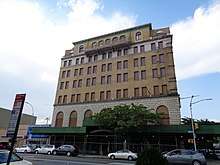
The southern portion of the Shore Theater (facing Surf Avenue) housed the offices, while the northern portion (away from Surf Avenue) housed the theater.[11]:6–8 The ground level contained storefronts housed within several bays. Above the ground floor is a double-height piano nobile along the southern and part of the eastern and western facades, which contains semicircular-topped windows corresponding to the bays below.[15] The third through fifth floors have buff-colored brick exteriors and a pair of rectangular windows in each bay. The sixth floor has a similar window layout but with a terracotta exterior and a frieze above it. The seventh floor was the top floor and contained buff brick exteriors, a frieze above it, and architectural setbacks at the corners.[11]:7
Exterior
The southern facade along Surf Avenue contains various storefronts, as well as a cornice above the ground level. The southern facade contains seven bays, the westernmost of which contains a rolldown gate that conceals a driveway. A doorway just to the east of the driveway contains rope molding, dressed stone blocks surrounding the doorway, and a carved stone marquee above it with the words "Coney Island Theatre Building". Dressed stone also surrounds another doorway under the marquee, as well as the piers at the extreme ends on the Surf and Stillwell Avenue facades.[11]:6 The seventh floor contains a central pavilion with five bays, containing terracotta ornamentation, as well as a porch.[11]:7 A vertical sign with the words "SHORE" was located at the southeastern corner, near the intersection of Surf and Stillwell Avenues, but was damaged and not replaced after Hurricane Sandy in 2012.[23][32]
The eastern facade on Stillwell Avenue also contains storefronts on the ground level. The office-building section to the south is similar to the southern facade, but the movie-theater facade is plain brick. The office building section contains three bays; on the piano nobile level, there are two narrow rectangular windows in between the two northernmost bays. The windows on the third through sixth floors do not correspond to the bays below, and there are seven windows on each floor. The northern part of the facade consists of a windowless blank wall with an emergency staircase from the theater affixed to it.[11]:7
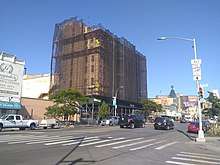
The western and northern facades, both of which originally faced neighboring structures, contain a simple design. On the southern part of the western facade, the wall is made of brick and there are three windows on each floor. The northern part of the western facade is a blank wall with an emergency staircase. The northern facade does not have any windows, but instead consist of slightly projecting blank walls.[11]:7
Interior
The Shore Theater had an auditorium in its northern portion, which in its heyday could fit 2,472 patrons.[37] The theater contains a 150-foot (46 m) domed ceiling. Charles Denson's pictures in 2006 showed that the theater contained several motifs that show the Halve Maen, a Dutch flyboat commandeered by Henry Hudson, as well as dancing mermaids.[32] According to a blog post by Denson, there was also a mosaic fountain at the mezzanine level, marble columns, and a lobby ceiling with nautical-themed lighting fixtures. A plaster artwork on the ceiling outside the auditorium was too badly damaged to be repaired.[26]
Commercial space occupied the first floor of the building's southern portion, while there was office space above it. These spaces were used by such tenants as a Head Start children's program, a Medicaid office, an office for a cigar company, and a dress manufacturer. The commercial space was occupied by a bar and then a Kansas Fried Chicken.[11]:6[15]
References
- "Coney Island History – Early History". Heart of Coney Island.
- "Yellowed Pages of Coney Island Register Reveal Visits of Many Great and Near-Great of Day". Brooklyn Daily Eagle. March 5, 1939. p. 11. Retrieved July 21, 2018 – via Brooklyn Public Library; newspapers.com

- "American Experience. Coney Island. People & Events". PBS. Retrieved November 13, 2015.
- Berman, J.S.; Museum of the City of New York (2003). Coney Island. Portraits of America. Barnes and Noble Books. ISBN 978-0-7607-3887-0. Retrieved November 13, 2015.
- Snyder-Grenier, Ellen M. (Ellen Marie) (1996). Brooklyn! : an illustrated history. Brooklyn Historical Society (Brooklyn, New York, N.Y.). Philadelphia: Temple University Press. ISBN 1566394082. OCLC 34282893.
- Cudahy, B.J. (2009). How We Got to Coney Island: The Development of Mass Transportation in Brooklyn and Kings County. Fordham University Press. ISBN 978-0-8232-2211-7. Retrieved July 23, 2018.
- "The Comprehensive History of Coney Island". Heart of Coney Island. Retrieved July 23, 2019.
- Judith N. DeSena; Timothy Shortell (2012). The World in Brooklyn: Gentrification, Immigration, and Ethnic Politics in a Global City. Lexington Books. pp. 147–176. ISBN 978-0-7391-6670-3.
- Parascandola, L.J. (2014). A Coney Island Reader: Through Dizzy Gates of Illusion. Columbia University Press. p. 24. ISBN 978-0-231-53819-0. Retrieved January 20, 2019.
- Denson, Charles. (2002). Coney Island : lost and found. Berkeley, Calif.: Ten Speed Press. ISBN 1580084559. OCLC 50253166.
- "Coney Island Theater" (PDF). New York City Landmarks Preservation Commission. December 14, 2010. Retrieved September 5, 2019.
- "Fight For His Shack Brings $5,000 Check; ' Fatty' Tom Langtry Agrees to Move and Let $400,000 Coney Island Theatre Be Built". The New York Times. April 11, 1925. ISSN 0362-4331. Retrieved September 6, 2019.
- "Coney Island's First All-Year Theater Completed Last Week; In Chanin Group". Brooklyn Daily Eagle. June 14, 1925. p. 21. Retrieved September 6, 2019 – via Brooklyn Public Library; newspapers.com

- "Start Foundation for Big Theater on Site of Old Coney Island Landmarks". Brooklyn Daily Eagle. May 25, 1924. p. 46. Retrieved September 6, 2019 – via Brooklyn Public Library; newspapers.com

- Diamonstein-Spielvogel, Barbaralee (2011), The Landmarks of New York, Albany, New York: State University of New York Press, p. 569, ISBN 978-1-4384-3769-9
- "Big Coney Island Theatre Completed at Two Million Cost". Brooklyn Times-Union. January 4, 1925. p. 2. Retrieved September 7, 2019 – via newspapers.com

- "Changes Under Way in Surf Ave. Show Progress of Coney". Brooklyn Daily Eagle. January 4, 1925. p. 58. Retrieved September 6, 2019 – via Brooklyn Public Library; newspapers.com

- "Loew Leases Coney Island Theatre". The New York Times. April 26, 1925. ISSN 0362-4331. Retrieved September 6, 2019.
- "Bay Ridge, Coney Island Theaters Add Vaudeville". Brooklyn Daily Eagle. September 29, 1941. p. 4. Retrieved September 7, 2019 – via Brooklyn Public Library; newspapers.com

- "Mt. Vernon Brandt's Opens With 'Bagels and Yox' Today". The New York Times. January 1, 1966. ISSN 0362-4331. Retrieved September 6, 2019.
- Zolotow, Sam (April 27, 1966). "2 More Theaters to Do Burlesque; Broadway and Coney Island Houses Booked by Griffith". The New York Times. ISSN 0362-4331. Retrieved September 6, 2019.
- Warerkar, Tanay (July 18, 2016). "Coney Island's Shore Theater, a weathered landmark, is reimagined". Curbed NY. Retrieved September 6, 2019.
- "Retail space at Coney Island's Shore Theater priced at $75 per square foot". Brooklyn Eagle. August 24, 2016. Retrieved September 6, 2019.
- Polgreen, Lydia (August 1, 2004). "Ballpark Hums, but Not the Neighborhood; Coney Island, Once a Wonderland of Whimsy, Is Still Waiting for a Rebirth". The New York Times. ISSN 0362-4331. Retrieved September 6, 2019.
- Bredderman, Will (August 9, 2013). "Designs in the works for new sign modeled on original". Brooklyn Paper. Retrieved September 6, 2019.
- Denson, Charles (January 22, 2019). "Coney Island's Shore Theater: What Survives?". Coney Island History Project. Retrieved September 7, 2019.
- Croghan, Lore (August 23, 2012). "The promised grandeur of Coney Island's Shore Theater shines through peeling plaster". New York Daily News. Retrieved September 6, 2019.
- MacDonald, Kerri (December 14, 2010). "Coney Island's Shore Theater Is Named a Landmark". City Room. Retrieved September 6, 2019.
- Mixson, Colin (January 29, 2016). "Shore thing! Developers buy landmarked Shore Theater, will reopen as entertainment spot". Brooklyn Paper. Retrieved September 6, 2019.
- "Shore Theater renderings revealed!". Brooklyn Paper. July 22, 2016. Retrieved September 6, 2019.
- Ramirez, Jeanine (August 21, 2018). "Coney Island could see first new hotel in over 50 years". Spectrum News NY1. Retrieved August 24, 2018.
- "Hotel makeover for Coney Island's Shore Theater heads back to the drawing board". Brooklyn Eagle. January 16, 2019. Retrieved September 7, 2019.
- "Hotel makeover for Coney Island's Shore Theater OK'd by Landmarks". Brooklyn Eagle. March 14, 2019. Retrieved September 6, 2019.
- "Shore Hotel Green-lighted by Landmarks Preservation Commission". bklyner.com. March 15, 2019. Retrieved September 6, 2019.
- Plitt, Amy (March 13, 2019). "Coney Island's Shore Theater will go hotel with LPC approval". Curbed NY. Retrieved September 7, 2019.
- "Final curtain: Shore Theater will re-open as hotel and spa - not entertainment venue". Brooklyn Paper. October 12, 2018. Retrieved September 7, 2019.
- "New rides and a boutique hotel to help reawaken Coney Island". 6sqft. August 23, 2018. Retrieved September 7, 2019.
External links
| Wikimedia Commons has media related to Shore Theater (Coney Island, Brooklyn). |
- Shore Theater at Cinema Treasures
.jpg)
